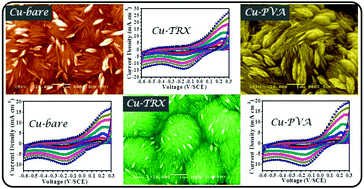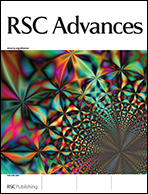Porous CuO nanosheet clusters prepared by a surfactant assisted hydrothermal method for high performance supercapacitors
Abstract
This investigation demonstrates the surfactant assisted fabrication of nanosheet clusters of caddice clew, yarn ball and cabbage slash-like microstructures of copper oxide (CuO) in thin film form directly grown onto a stainless steel substrate using a binder free hydrothermal approach. The impact of organic surfactants such as Triton X-100 (TRX) and polyvinyl alcohol (PVA) on the structural, morphological, surface area and electrochemical properties of CuO is investigated. The X-ray diffraction study reveals the structure-directing ability of the organic surfactants and confirms the nanocrystalline nature of the CuO thin films. Additionally, these CuO microstructures show excellent surface properties like uniform surface morphology, good surface area and a uniform pore size distribution. The electrochemical tests manifest a high specific capacitance of 535 F g−1 at a scan rate of 5 mV s−1 with 90% capacitive retention after 1000 cycles and low dissolution and charge transfer resistance of the yarn ball-like structured CuO thin film. This approach renders a plain picture of the process–structure–property relationship in thin film synthesis and provides significant schemes to boost the performance of supercapacitor electrodes.


 Please wait while we load your content...
Please wait while we load your content...